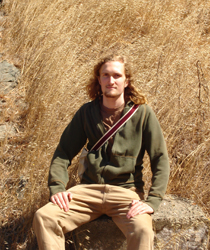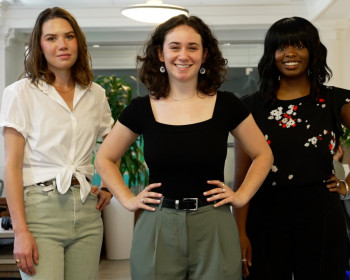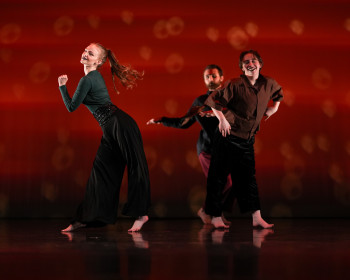Senior Avery Welkin, a sociology and anthropology major from Olympia, Washington, who completed an internship with AFSC last summer, is coordinating the exhibit’s appearance at Lewis & Clark. He spoke with Public Affairs and Communications about the project and his hopes for its impact on the community.
What is the American Friends of Service Committee, and how did you get involved with the group and with this exhibit?
The American Friends Service Committee is a Quaker peace and social justice organization that has been working on service and development projects domestically and abroad for more than 90 years. Growing up Quaker, I was always aware of the many events and programs that the AFSC puts on all over the country. I got directly involved last summer, working with the Peace Education division in San Francisco, through the Metta Center for Nonviolence Education.
Eyes Wide Open is one of AFSC’s most successful recent projects, having toured nationally since 2004. During its spring tour of Oregon, the exhibit will visit college campuses as well as smaller towns and local venues.
Is there anything else you’ve worked on to promote peace?
I’ve been involved with peace work for most of my life, partly due to the values of integrity, nonviolence, and social justice instilled in me by my Quaker upbringing. My most recent work was with the Metta Center for Nonviolence Education and the AFSC in the Bay Area, where I participated in workshops ranging from nonviolence to community organizing and diversity with 10 other interns from around the country, each working in different organizations for nonviolence, peace, and social justice. I was working with the AFSC, organizing a conference on state violence and compiling information on alternatives to military service for young adults.
I believe that real, lasting peace comes about through mutual understanding and communication between people across cultures, ethnicities, and national boundaries.
Why do you feel it’s important for Lewis & Clark to host this exhibit?
Most students at Lewis & Clark do not feel the immediacy of the Iraq War like others in our generation, who are fighting there or who have siblings or friends there. We may talk about the war in our classes, but for many of us, personal connections—details that would humanize the face of the conflict—are missing.
The purpose of Eyes Wide Open is to emphasize and bring home the human cost of war, to help everyone experience a representation of the lives being lost in Oregon, the United States, and in Iraq. As college students, we have the power to influence policy decisions, to make our voices heard, and to create direct action for peace and social justice in so many different arenas. Hosting Eyes Wide Open at L&C can help remind the community what is going on overseas and exactly how it affects us here.
What do you hope people take away from the experience?
Eyes Wide Open creates a space for people to reflect on the costs of war, to learn about what is going on in Iraq, and to realize the impact the conflict has on our local and national communities.
This memorial exhibit is not meant to elicit more political debates, which there are already plenty of on campus and across the country. Instead, it gives us a chance to connect—on a profoundly human, emotional level—with the consequences of war and the experiences of individuals affected by it.
We hope that when people visit, they share their thoughts and feelings with each other, visit some of the informational tables, and leave with thoughts of how to end this war. We also hope that Eyes Wide Open will encourage people to be more sensitive to those in the L&C community who have friends or family in Iraq, or have been there themselves.
Is this exhibit politically motivated?
The AFSC’s motive behind Eyes Wide Open is to move beyond the typical political arguments to visually underscore the human cost of war. While the AFSC does support specific progressive political goals in other programs, the message of this Oregon tour of Eyes Wide Open is simply “Peace is Possible.” This statement of hope is non-partisan, and the exhibit is for people of all political persuasions to experience the human connections behind the armor and the TV news. Regardless of political parties, this war takes a toll on all of our communities, and we must all work to guide our people out of harm’s way.
How is this exhibit different than the national tour?
This exhibition of Eyes Wide Open has been modified and focused on Oregon in order to emphasize the cost of the Iraq War to our state. There are more than 107 pairs of boots, representing each Oregon soldier who has died, with his or her name, age, hometown, and photo attached. Hardhats represent Oregon contractors who have been killed in Iraq. Data on the economic cost to Oregon will be made available through the National Priorities Project. The whole exhibit is specially tailored to underscore the impact of the war on our state and our people.
The exhibit will appear at Lewis & Clark on March 3, on the Glade, the grassy area located between Frank Manor House and Pamplin Sports Center.


